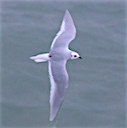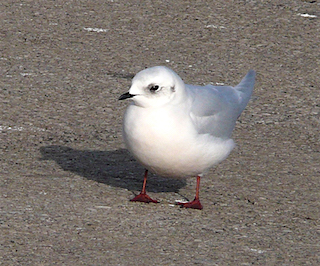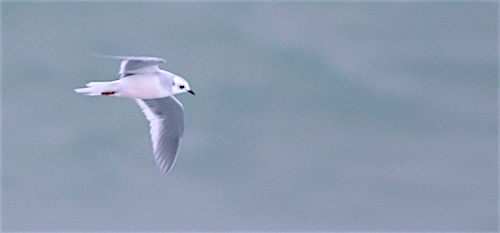 This pretty, small gull is native to the High Arctic of Canada and Siberia. This vagrant was spotted early in January 2016 flying by Lizard Point.
This pretty, small gull is native to the High Arctic of Canada and Siberia. This vagrant was spotted early in January 2016 flying by Lizard Point.
Photo: Tony Blunden
Scientific name: Rhodostethia rosea
Conservation status: IUCN, Least Concern.
What to look for:
- Colouring and appearance: Small, red-legged gull with pointed wings and tail that is wedge-shaped. Breeding plumage in adults: light grey back, white underparts and a pink-flushed breast, small dark bill and a distinctive black ring round the neck. In winter, there is no black neck ring nor a pink flush, but a small dark patch is seen behind the eye.
- Size: Wingspan 73 to 80 cm, length 29 to 32 cm.
- Where: Vagrant species round the coast in winter.
- Call: Silent in winter.
- Similar species: Little Gull, which is slightly smaller and has less-pointed wings.
 The Ross’s Gull is a truly Arctic species. It calls the High Arctic of Siberia and Canada its home, breeding in the tundra. As autumn approaches it migrates south, but usually only as far as the Bering and Okhotsk Seas (though some are now reported from the USA), staying close to the edge of the pack-ice. There are occasional records in Britain: these are all, of course, vagrants.
The Ross’s Gull is a truly Arctic species. It calls the High Arctic of Siberia and Canada its home, breeding in the tundra. As autumn approaches it migrates south, but usually only as far as the Bering and Okhotsk Seas (though some are now reported from the USA), staying close to the edge of the pack-ice. There are occasional records in Britain: these are all, of course, vagrants.
In its breeding grounds, Ross’s Gulls nest on the ground in small colonies, sometimes in company with other seabirds, such as the Arctic Tern. It is possible that Arctic Terns’ aggressive behaviour in defending their own nests benefits Ross’s Gulls. They have a preference for nesting on small islands in shallow pools as nest sites, or on hummocky ground in marshes. The clutch size is small: two to three reddish-speckled olive-coloured eggs laid in the seaweed- and moss-lined nest. The young are left to fend for themselves from only a few days after hatching.
Ross’s Gulls feed on invertebrates, including insects and crustaceans, and on small fish.
Did you know…?
…It might not be native to the UK, but Ross’s Gull is named after Sir James Clark Ross, a nineteenth century British Arctic and Antarctic explorer.
…The global population of Ross’s Gull is below 10,000 individuals.

More information and references:
Svensson, L., Mullarney, K., Zetterstrom, D.,1986. Collins Bird Guide, second edition (translated by Christie, D., Svensson, L.). HarperCollins, London.
Published: January 2016
Author: Amanda Scott
Photos: Lower : Tony Blunden; upper: By Seabamirum (Flickr) [CC BY 2.0]
